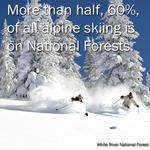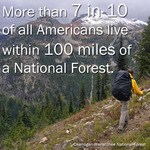13 March 2015 - Most Americans can name several National Parks.
Ask the same person to name a few National Forest and they’ll probably struggle to identify more than one. The National Forest System is a vast and rich component of our public lands. Check out this list to learn more about these amazing places. Then take a weekend and explore the one nearest you, chances are it’s within a couple hours’ drive.

Forests provide nesting places and safe cover for many species of birds and other animals, which rely on them for food such as fruits, nuts, leaves, bark and roots. Forests protect fish habitats by preventing erosion, filtering pollutants, and shading cooling waters.
With 155 National Forests in 44 different states, you’re never far from your backyard forest.

National Forests are home to 122 ski areas and countless miles of backcountry access.
Millions of Americans visit National Forests who contribute to the local economy through trips, lodging, food and recreation.
Stretching for more than 9,000 miles, scenic byways on our National Forests provide access to stunning views and iconic locations across the country.
Congressionally-designated Wild and Scenic Rivers are preserved for natural, cultural and recreational values for today and tomorrow.
Head over to Deschutes National Forest and the Newberry National Volcanic Monument which includes more than 50,000 acres of lakes and lava flows in Central Oregon. Who could forget the Mount St. Helens National Volcanic Monument on the Gifford Pinchot National Forest?
3.8 million acres of National Grasslands are managed for fish and wildlife, timber, water and recreation.

The Tongass stretches along the coast of Southeast Alaska and is part of the world’s largest temperate rain forest.
The National Forest System was created in the early twentieth century to protect our nation’s largest source of freshwater. Millions of Americans depend on National Forests every time they turn on their taps, eat fresh produce, or water their gardens.




